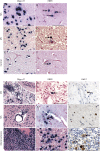Molecular signature of Epstein-Barr virus infection in MS brain lesions
- PMID: 29892607
- PMCID: PMC5994704
- DOI: 10.1212/NXI.0000000000000466
Molecular signature of Epstein-Barr virus infection in MS brain lesions
Abstract
Objective: We sought to confirm the presence and frequency of B cells and Epstein-Barr virus (EBV) (latent and lytic phase) antigens in archived MS and non-MS brain tissue by immunohistochemistry.
Methods: We quantified the type and location of B-cell subsets within active and chronic MS brain lesions in relation to viral antigen expression. The presence of EBV-infected cells was further confirmed by in situ hybridization to detect the EBV RNA transcript, EBV-encoded RNA-1 (EBER-1).
Results: We report the presence of EBV latent membrane protein 1 (LMP-1) in 93% of MS and 78% of control brains, with a greater percentage of MS brains containing CD138+ plasma cells and LMP-1-rich populations. Notably, 78% of chronic MS lesions and 33.3% of non-MS brains contained parenchymal CD138+ plasma cells. EBV early lytic protein, EBV immediate-early lytic gene (BZLF1), was also observed in 46% of MS, primarily in association with chronic lesions and 44% of non-MS brain tissue. Furthermore, 85% of MS brains revealed frequent EBER-positive cells, whereas non-MS brains seldom contained EBER-positive cells. EBV infection was detectable, by immunohistochemistry and by in situ hybridization, in both MS and non-MS brains, although latent virus was more prevalent in MS brains, while lytic virus was restricted to chronic MS lesions.
Conclusions: Together, our observations suggest an uncharacterized link between the EBV virus life cycle and MS pathogenesis.
Figures





Similar articles
-
High prevalence of a 30-base pair deletion in the Epstein-Barr virus (EBV) latent membrane protein 1 gene and of strain type B EBV in Mexican classical Hodgkin's disease and reactive lymphoid tissue.Hum Pathol. 1999 Jul;30(7):781-7. doi: 10.1016/s0046-8177(99)90138-7. Hum Pathol. 1999. PMID: 10414496
-
Comparison of in situ hybridization using different nonisotopic probes for detection of Epstein-Barr virus in nasopharyngeal carcinoma and immunohistochemical correlation with anti-latent membrane protein antibody.Lab Invest. 1992 Oct;67(4):457-64. Lab Invest. 1992. PMID: 1331609
-
Epstein-Barr virus is present in the brain of most cases of multiple sclerosis and may engage more than just B cells.PLoS One. 2018 Feb 2;13(2):e0192109. doi: 10.1371/journal.pone.0192109. eCollection 2018. PLoS One. 2018. PMID: 29394264 Free PMC article.
-
Epstein-Barr virus infection and its gene expression in gastric lymphoma of mucosa-associated lymphoid tissue.J Med Virol. 1998 Dec;56(4):342-50. doi: 10.1002/(sici)1096-9071(199812)56:4<342::aid-jmv10>3.0.co;2-p. J Med Virol. 1998. PMID: 9829640
-
Frequent presence of latent Epstein-Barr virus infection in lymphoepithelioid cell lymphoma (Lennert's lymphoma).Histopathology. 1994 Oct;25(4):331-7. doi: 10.1111/j.1365-2559.1994.tb01351.x. Histopathology. 1994. PMID: 7835838
Cited by
-
Epstein-Barr Virus-Specific CD8 T Cells Selectively Infiltrate the Brain in Multiple Sclerosis and Interact Locally with Virus-Infected Cells: Clue for a Virus-Driven Immunopathological Mechanism.J Virol. 2019 Nov 26;93(24):e00980-19. doi: 10.1128/JVI.00980-19. Print 2019 Dec 15. J Virol. 2019. PMID: 31578295 Free PMC article.
-
N2 year in review.Neurol Neuroimmunol Neuroinflamm. 2019 Dec 12;7(1):e644. doi: 10.1212/NXI.0000000000000644. Print 2020 Jan. Neurol Neuroimmunol Neuroinflamm. 2019. PMID: 31831570 Free PMC article. No abstract available.
-
B Cells in Multiple Sclerosis and Virus-Induced Neuroinflammation.Front Neurol. 2020 Nov 3;11:591894. doi: 10.3389/fneur.2020.591894. eCollection 2020. Front Neurol. 2020. PMID: 33224101 Free PMC article. Review.
-
Epstein Barr Virus Exploits Genetic Susceptibility to Increase Multiple Sclerosis Risk.Microorganisms. 2021 Oct 21;9(11):2191. doi: 10.3390/microorganisms9112191. Microorganisms. 2021. PMID: 34835317 Free PMC article. Review.
-
Epstein-Barr Virus and Multiple Sclerosis: A Convoluted Interaction and the Opportunity to Unravel Predictive Biomarkers.Int J Mol Sci. 2023 Apr 17;24(8):7407. doi: 10.3390/ijms24087407. Int J Mol Sci. 2023. PMID: 37108566 Free PMC article. Review.
References
Grants and funding
LinkOut - more resources
Full Text Sources
Other Literature Sources
Research Materials
